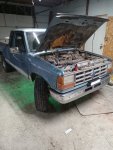lil_Blue_Ford
Cut & Weld
TRS Forum Moderator
⭐Supporting Member
💻 TRS Socials
TRS Event Participant
TRS 20th Anniversary
TRS 25th Anniversary
V8 Engine Swap
- Joined
- Aug 6, 2007
- Messages
- 11,687
- Points
- 3,101
- City
- Butler
- State - Country
- PA - USA
- Vehicle Year
- 2000
- Vehicle
- Ford Ranger
- Engine
- 5.0
- Transmission
- Automatic
- Total Drop
- 4”
So… I’ll use concrete blocks sometimes, with an explanation. Concrete blocks are often referred to as cinder blocks but the two are actually a little different concrete blocks are what you mostly find for sale these days and are stronger than true cinder blocks, but still brittle. I do not use hollow core concrete blocks, except to weigh tarps down or build with. I have occasionally used ”termite” block (cored on one side and solid on the other), but usually that’s because it’s needed and all I had and I will build a level, compacted limestone spot to set it on. I will also use solid block and treat them the same way, they sit on level compacted limestone, and I do the same for any stone (I have a couple cut sandstone blocks I’ll use for jackstand pads), wood or steel pads I use. Always worried about just this thing happening which is why I re-set some things and added an extra house jack and tried to keep it as stable as possible. I think no matter what it’s the uncertainty of not being on concrete or asphalt.Perhaps this is a good place and time to mention that no one recommends cinder blocks. Some years ago I purchased some for another project (but not for the truck). I grabbed one when I was loading at the lumberyard and it fell apart in my hands.
Sometimes I use ramps. Now I wonder if they are any safer. And just thinking out loud here: maybe if working on wheels it might even be safer to jack the truck up, slide the ramp under the frame, making sure to have boards underneath, and let the truck rest on them?
Maybe nothing is certain on loose gravel or soft ground.













